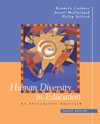 |
1 |  | 
Which of the following is one of the philosophical bases for inclusion? |
|  | A) | the belief that all members of a learning community should be alike |
|  | B) | the belief that communities of learners are, by definition, inclusive |
|  | C) | the belief that heterogeneity is avoidable |
|  | D) | the belief that homogeneity is desirable |
 |
 |
2 |  | 
An important philosophical principle underlying inclusive education for students with disabilities is: |
|  | A) | realism |
|  | B) | assimilation |
|  | C) | normalization |
|  | D) | accommodation |
 |
 |
3 |  | 
All of the following are part of the legal basis for inclusion, except: |
|  | A) | Section 504 of the Vocational Rehabilitation Act (1973) |
|  | B) | P.L. 94-142, amended as IDEA (1975, 1990) |
|  | C) | Americans with Disabilities Act (ADA) |
|  | D) | Title IX, Educational Amendments (1972) |
 |
 |
4 |  | 
Explicit definitions of each category of disability are particularly important because: |
|  | A) | definitions make educators more comfortable |
|  | B) | parents need definitions in order to deal with their children |
|  | C) | the allocation of financial resources is involved |
|  | D) | none of the above |
 |
 |
5 |  | 
All of the following were concerns of 19th century reformers in working with people with disabilities, except: |
|  | A) | proper care |
|  | B) | religious instruction |
|  | C) | vocational instruction |
|  | D) | maximum independence and integration into society |
 |
 |
6 |  | 
Specialized instruction of children with disabilities in common schools began: |
|  | A) | at the turn of the twentieth century |
|  | B) | before the Civil War |
|  | C) | right after the Civil War |
|  | D) | during the 1960s |
 |
 |
7 |  | 
P.L. 94-142, the Education of All Handicapped Children Act, amended in 1990 as P.L. 101-476, the Individuals with Disabilities Education Act (IDEA), mandated: |
|  | A) | zero exclusion of children with disabilities |
|  | B) | exclusion of children with disabilities only if due process guidelines are followed |
|  | C) | exclusion of children with severe intellectual or physical disabilities |
|  | D) | exclusion of children with severe emotional or behavioral problems |
 |
 |
8 |  | 
The number of children in school who have chronic illnesses has increased in the past two decades because: |
|  | A) | medical diagnoses have improved |
|  | B) | schools have become more accepting of sick children |
|  | C) | life-saving interventions have been developed for premature infants |
|  | D) | teachers are better trained in the instruction of children with chronic illnesses |
 |
 |
9 |  | 
Collaboration between professionals and families in the interest of children with disabilities: |
|  | A) | is usually not possible due to lack of interest and involvement on the part of parents |
|  | B) | means going beyond the actual legal requirements |
|  | C) | means following the letter of the law |
|  | D) | means professionals should do whatever parents want for their child |
 |
 |
10 |  | 
Early ideas of curriculum for children with disabilities focused primarily on: |
|  | A) | institutionalization |
|  | B) | academic achievement |
|  | C) | employability |
|  | D) | none of the above |
 |



 2003 McGraw-Hill Higher Education
2003 McGraw-Hill Higher Education